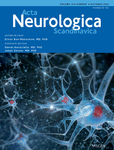Predictors of mortality for acute vertebrobasilar artery occlusion receiving endovascular treatment
Min Wu and Mingming Zha should be considered as joint first authors.
Funding information
This study was supported by the National Natural Science Foundation of China (No. 81870946 and U20A20357)
Abstract
Objectives
Acute vertebrobasilar artery occlusion (VBAO) is a devastating type of stroke with a high mortality rate. This study aimed to investigate the predictors of 3-month and 1-year mortality in VBAO patients receiving endovascular treatment (EVT).
Materials & Methods
Consecutive acute VBAO patients undergoing EVT between January 2014 and December 2019 were retrospectively analyzed in a prospectively maintained database. Multivariate logistical regression models were used to explore the potential predictors of mortality at 3 months and 1 year, respectively. The discrimination of the final model was assessed with the area under the receiver operating characteristic curve.
Results
A total of 100 patients were enrolled in this study (mean age 62 years; 77.0% male). After excluding patients lost to follow-up, the overall mortality rate was 34.3% (34/99) at 3 months and 45.4% (44/97) at 1 year. The Glasgow Coma Scale (GCS) score at 24 h (Odds ratio [OR], 0.676; 95% confidence interval [CI], 0.540–0.846; p = .001) and mechanical ventilation (MV) (OR, 7.356; 95% CI, 2.200–24.593; p = .001) were predictors of 3-month mortality after adjusting for potential confounders in multivariable analysis. Furthermore, the GCS score at 24 h (OR, 0.714; 95% CI, 0.590–0.864; p = .001), intracranial hemorrhage (OR, 7.330; 95% CI, 1.772–30.318; p = .006), and MV (OR, 5.804; 95% CI, 1.841–18.294; p = .003) were independently associated with mortality at 1 year. Sensitivity analyses showed similar results.
Conclusion
The 24-h GCS score and MV were common predictors of 3-month and 1-year mortality, and ICH was an additional predictor of 1-year mortality.
CONFLICTS OF INTEREST
None.
Open Research
DATA AVAILABILITY STATEMENT
The data that support the findings of this study are available from the corresponding author on reasonable request.




